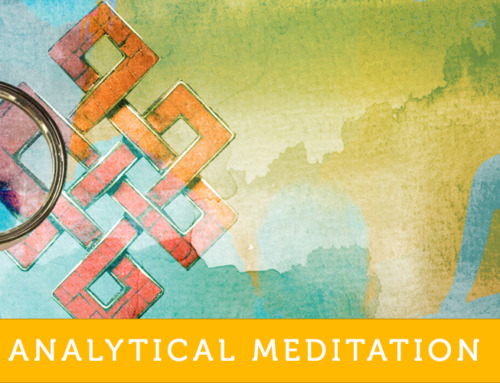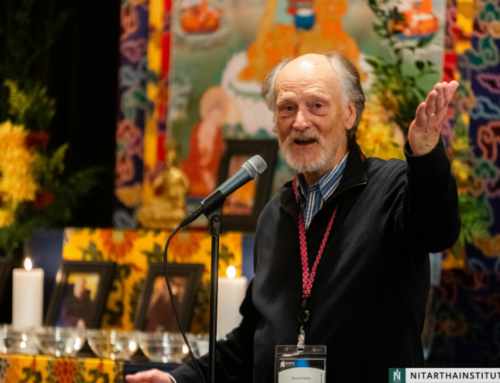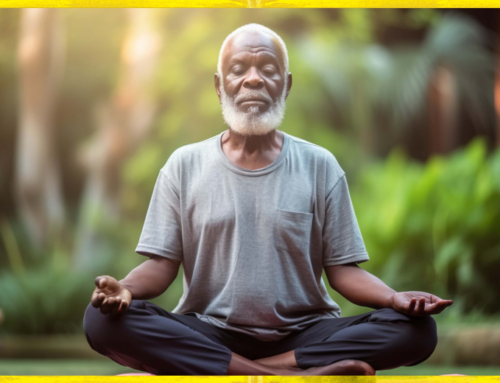This excerpt is copyrighted material, please do not use or copy without written permission from Nitartha Publications.
The following is part II of an excerpt from Commentary on Hinayana Tenets by Acharya Sherab Gyaltsen (You can read part I here). This is included in the introduction section of the sourcebook we use in our Mind & its World I course. Some things we learn about in details in the course rare:
- Divisions of mind
- Definitions of valid cognition
- Definition of direct valid cognition
- Sense direct valid cognition
- Two truths in Vaibhashika and Sautrantika view
- Process of perception in Vaibhashika and Sautrantika view
- Mental direct valid cognition
- Self-aware direct valid cognition
- Yogic direct valid cognition
- Seeming direct cognition
- Definition of inferential valid cognition for oneself and for others
- Appearing object, referent object, object of engagement
- Nonvalid cognition
- Three results of valid cognition
- …and much more
Hearing, Contemplation & Meditation I
Acharya Sherab Gyaltsen
The Buddha, the teacher who is the perfect Blessed one, taught two types of teachings: the teachings of scripture and the teachings of realization, and it has been over thirty years now that these two teachings have been spreading in this land.
EXPLANATION & PRACTICE SECTIONS
The Buddha taught methods to increase and propagate these two forms of teachings. As a method to increase the teachings of scripture, the Buddha taught that one must engage in explanation and listening. AS a method to propagate the teachings of realization, the buddha taught that one must engage in the practice of the path. For the former, there is a section that concentrates on increasing the teachings of the scriptures, and it is the explanation section. As for the latter, the practice section propagates the teachings of realization.
As far as the practice section is concerned, even though all three elements of hearing, contemplating, and meditating are present, what is foremost is meditation. This is not to say that one meditates in the practice section without doing any hearing or contemplation—all three are present—but what is foremost in the practice is meditation.
From the perspective of the explanation section, again the threefold combination of hearing, contemplating, and mediation is present. Here, however, hearing and contemplating are emphasized rather than meditation.
From the perspective of progressively engaging the view, it is taught that between the explanation section and the practice section, the explanation section comes first. Therefore what we are engaged in here at Nitartha is primarily the section of explanation. Even in the explanation section, however, there is meditation. To attain the ultimate final result, the state of buddhahood, the most important thing is meditation. But to have correct or good meditation, one has to have correct contemplation, and to have correct contemplation,one has to rely on correct listening or hearing. Therefore we start in this way hearing.
PROGRESSION OF HEARING, CONTEMPLATING & MEDITATING
We engage in the explanation section through reasoning. We engage in hearing the dharma in a way that concords with proper reasoning, as opposed to mere superficial understanding. Listening to the dharma can be divided into two classes. There are those who listen merely to get an understanding, and there are those who listen while exercising their ability to reason. The latter one, listening while exercising one’s ability to reason, is what we are trying engage in here.
Through what reasoning do we hear the teachings, and through what reasonings do we follow these teachings? We follow a progression of reasonings. We can all say that we are individuals who desire liberation and peace and who do not want suffering. Not only that, but we are individuals who are looking for the ultimate peace. From that perspective, we can say that hearing the dharma is important. Why is it important? Because contemplation is important. Why is contemplation important? Because meditation is important for the attainment of these goals. And why is meditation important? Because attaining the ultimate result of buddhahood is important. This is the progression of reasonings we use to decide that hearing is important.
First we hear the teachings of the Buddha, then we contemplate what we have heard, and finally, we meditate on our contemplation. Let us take for example a person who suffers from hunger. What is the most important thing this person needs?
For beginners on the path, the most important thing is to engage in hearing the dharma. The Buddha taught numerous methods of cutting the root of ignorance, the clinging to a self-identity. To cut the root of ignorance, one needs to learn and understand these methods. If one relies on a lama or a spiritual friend in the manner of trying to engage in these methods without first understanding them, one will not be able to cut the root of clinging to a self-identity, and consequently will not be able to relinquish suffering. Thus the principle reason for the importance of hearing is that we understand the methods to cut the root of ignorance.
Therefore we engage in hearing, contemplating, and meditating in a progressive order. First we hear the teachings of the Buddha, then we contemplate what we have heard, and finally, we meditate on our contemplation. Let us take for example a person who suffers from hunger. What is the most important thing this person needs? Obviously, this person needs to eat food. Food will alleviate his or her suffering. What do we do to eat the food of meditation? To eat the food of meditation. We need to know how to make the food, so we need to be skilled in the way of making the food. This is contemplation. Next, to know how to make the food, we have to learn what the food is made of, what causes and conditions have to come together for the food to be made properly, and so on. This is akin to hearing. To sum up, the skill to know what causes and conditions come together to make the food is similar to hearing, and actually making the food is similar to contemplation. However, just having made the food will not suffice. We have to eat it, and eating the food is similar to meditation.
Drawing from this analogy, obviously, the first thing we need to learn is how to hear the dharma. It is said that hearing is like a torch that dispels ignorance. This scriptural citation praises the qualities of hearing. It is important to know the qualities of hearing because if we do not know the qualities of hearing, we will not give rise to any kind of joy or delight towards hearing the dharma.
Continue reading part II here…





